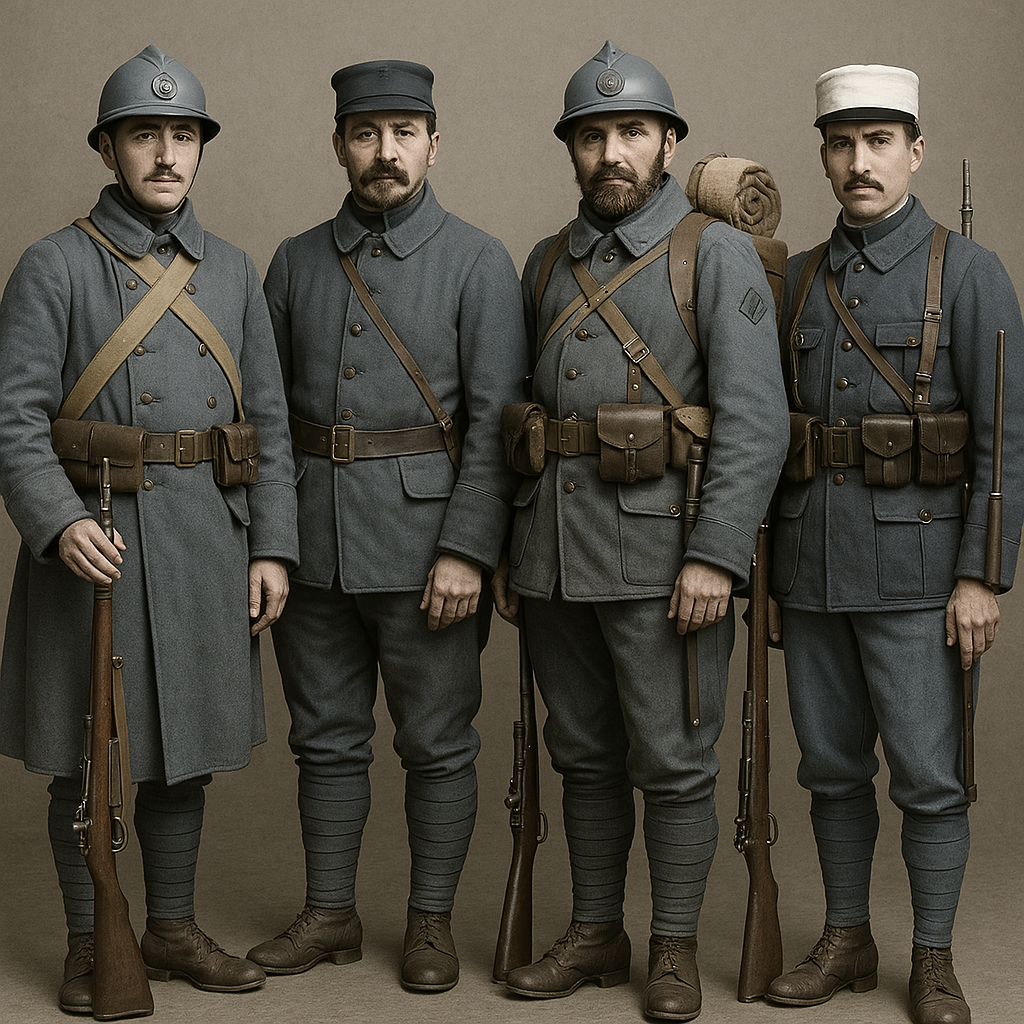
Uniform Components of the French Soldiers in World War I: From the Battle of the Somme to the French Foreign Legion Equipment
Published on Apr 13, 2025
Uniform Components of the French Soldiers in World War I: From the Battle of the Somme to the French Foreign Legion Equipment
introduction
The history of military uniforms is as complex as the battles in which they were worn. For collectors and enthusiasts alike, understanding the uniform components of a World War I French soldier is essential. Not only does it provide insight into the practicalities of warfare, but it also reflects the evolving tactics and harsh realities faced by soldiers, especially during iconic battles like 1916 the Somme and in units like the French Foreign Legion.
In this detailed article, we’ll explore the components of French military uniforms, their evolution, and how they played a pivotal role in battles such as the Somme and Verdun.
The Foundation of the French Military Uniform in World War I
At the dawn of World War I, the French military uniform was more about tradition than practicality. The infamous bright red trousers and blue coats, known as the "tenue garance," were ill-suited for modern warfare. These bright colours, while rooted in history, made soldiers easy targets on the battlefield.
Transition to the "Horizon Blue"
By 1915, after heavy losses, the French Army adopted the "horizon blue" uniform. This light blue-grey fabric provided better camouflage in the mud and smoke of the trenches, especially during brutal campaigns like the Battle of Verdun. The uniform typically included:
- Horizon blue wool tunic and trousers: Thick and warm, yet breathable.
- Adrian helmet: Introduced in 1915, this steel helmet became a lifesaving addition against shrapnel.
- Leather boots and gaiters: Designed to provide ankle support and protection against trench conditions.
- Canvas or leather belts and ammo pouches: Essential for carrying ammunition and supplies.
The switch to Horizon Blue was not just a fashion choice; it was a tactical decision that saved countless lives in the trenches of France.
Uniform Components at the Battle of the Somme (1916)
The Battle of the Somme in 1916 is one of the most infamous battles in World War I history, with over a million casualties. The French forces, alongside the British, faced horrendous conditions. The soldiers' uniforms had to withstand mud, rain, and relentless artillery fire.
Essential Gear at the Somme:
- Gas masks: Mustard gas and other chemical weapons were widely used. The M2 gas mask became a standard issue to protect soldiers from lethal gas attacks.
- Puttees: Long strips of cloth wrapped around the lower leg for added warmth and to prevent mud from entering boots.
- Greatcoats: Heavy wool coats that offered protection from the cold and rain.
- Personal kit: Soldiers carried essentials like a water bottle, mess tin, and an entrenching tool for digging defensive positions.
Uniforms were often covered in mud and grime, and soldiers frequently personalized their gear for practical reasons, such as reinforcing buttons or patching holes to extend usability.
The Role of Uniforms in the Battle of Verdun
The Battle of Verdun in 1916, known for its relentless bombardment and staggering casualties, further tested the limits of the French uniform design.
Key Uniform Adaptations at Verdun:
- Enhanced helmets: The Adrian helmet saw improvements, with a thicker metal crest to better deflect shrapnel.
- Camouflage: Soldiers increasingly used mud and foliage to improve concealment.
- Layering techniques: To combat the freezing temperatures, soldiers layered uniforms and used makeshift insulation.
The harsh lessons from Verdun led to better uniform adaptations, which would influence military attire for years to come.
French Foreign Legion Equipment: Rugged and Reliable
The French Foreign Legion, renowned for its fierce reputation, required specialized equipment and uniform components suitable for diverse terrains and intense combat situations.
French Foreign Legion Uniform Features:
- Khaki uniforms: Unlike regular French infantry, the Legion often wore khaki for better camouflage in varied environments.
- Légionnaire kepi: The iconic white kepi, though more ceremonial today, was originally practical for desert heat protection.
- Leather bandoliers and cartridge belts: Designed for easy access to ammunition.
- Field packs: Carried additional supplies, including spare clothes, cooking equipment, and survival gear.
The Foreign Legion’s gear was built for endurance, enabling soldiers to operate effectively in some of the most hostile environments.
The Importance of Uniform Components in Morale and Identity
Uniforms in World War I were more than just functional; they were a source of pride and identity. For French soldiers, wearing the horizon blue uniform or the distinct attire of the Foreign Legion fostered a sense of unity and resilience.
Additionally, uniform components such as badges, insignia, and medals allowed soldiers to display their rank and achievements, contributing to morale even in the darkest moments of the war.
Collecting French World War I Uniforms Today
For collectors and historians, original French World War I uniforms and French Foreign Legion equipment offer a tangible connection to the past. Whether it’s an Adrian helmet from 1916, the Somme, or a well-preserved légionnaire's kepi, these artefacts tell stories of bravery, hardship, and historical significance.
When collecting, look for authentic stitching, fabric types, and unit markings. Authentic pieces not only hold historical value but also provide educational insights into the lives of soldiers who wore them.
Conclusion
The uniform components of French soldiers during World War I reflect both the hardships and heroism of the era. From the muddy trenches of the Battle of the Somme to the rugged campaigns of the French Foreign Legion, every button, belt, and boot played a crucial role in a soldier’s survival and identity.
For enthusiasts, historians, and collectors, understanding these components offers a deeper appreciation of military history. At Paddelaters.com, we’re proud to bring this history to life, offering authentic reproduction uniforms that capture the spirit of the brave men who wore them.
